Complexes or chelates?
Generically speaking, the term ‘complex’ can be used to describe the product formed when a metal ion reacts with a bonding group or ligand that contains an atom which has a lone pair of electrons. In the complex, the ligand is bonded to the metal ion through donor atoms such as oxygen, nitrogen or sulphur. Ligands that contain only one donor atom are termed ‘monodentate’, whilst those that contain two or more donor atoms capable of bonding to a metal ion are termed bi-, tri or tetradentate. These multi donor species can also be referred to as polydentate (Byrne, 2010)
When such ligands bond to a metal ion via two or more donor atoms on the same ligand, the compIex formed contains one or more heterocyclic rings which contain the metal atom. Such complexes are termed as ‘chelates’ (from the Greek; chele, referring to a crab’s claw).
Amino acids such as glycine are examples of bidentate Iigands which bond to metal ions via an oxygen of the carboxylic acid group and the nitrogen of the amino group. In contrast, ethylenediaminetetraacetic acid (EDTA) is an example of a hexadentate ligand containing six donor atoms. It forms highly stable complexes with most metal ions and in fact is not particularly useful for the formation of mineral chelates as the bioavailability of such complexes is negligible (Byrne, 2010).
It must also be remembered that while all chelates are complexes, not all complexes are chelates. Indeed, whilst the overall theory behind chelation is simple, there are a number of criteria which must be absolutely met in order to ensure the generation of a stable mineral chelate
- A chelating ligand must contain at least two atoms capable of forming bonds with the metal ion
- The ligand must form a heterocyclic ring with the metal as the closing member of the ring
- It must be physically (sterically) possible to chelate the metal
- The ratio of the ligand to the mineral must meet minimum requirements for stability
True chelates have the ‘ring structure’ formed by bonding between the amino and carboxyl ends of the amino acid and the metal ion.
Amino acids and peptides as ligands
The chemistry behind OTMs has created a great deal of confusion in the animal feed industry. Terms such as metal amino acid complexes, metal amino acid chelates, metal polysaccharide complexes and metal proteinates abound, yet official definitions remain vague and unhelpful. As an example, definitions of the most common organic trace minerals used in agricultural practice as laid down by the Association of American Feed Control Officials (AAFCO, 1998) are illustrated in table 1.
Table 1. AAFCO definitions for organic mineral complexes (AAFCO, 1998).
In deference to the AAFCO definitions, table 2 gives an overview of the EU classification of organic zinc products from which one can appreciate the stark differences between the official terminologies used for regulatory control and the obvious confusion that can occur when comparing products.
Table 2. EU classification of organic zinc products
An important feature of organic chelates is their enhanced stability due to the conformation in which the metal is held by the bonding group(s). In general terms, the stability of a chelate is the defining characteristic of its bioavailability and chelates with low stabilities will see the effectiveness of the product reduced to that of the corresponding inorganic salt. Individual bonding groups such as amino acids or peptides, have the potential to form complexes or chelates with varying degrees of stability. It is reasonable to expect that bonding groups, such as peptides, which have a greater number of donor atoms would have higher stabilities than simple amino acids such as glycine. Arising from this, one would anticipate that peptide based chelates will have the necessary physico-chemical properties to ensure wide ranging stability under conditions of changing pH (Murphy, 2018a, 2018b).
Stabilising a chelate – the effect of ligand.
When trying to compare chelates or complexes on the basis of “which is best under this set of conditions”, one really needs to consider many different factors. However, it is useful to compare products in terms of what’s known as their stability constant. A stability constant (also known as a formation constant or a binding constant) is an equilibrium value for the formation of a complex or chelate in solution (Martell and Motekaitis, 1992). The overall stability constant is the product of all stepwise stability constants. For example, if K1 and K2 are the stability constants for the addition of the first and second ligand respectively, then the overall stability constant (β2) is K1 x K2.
This value is a relative measure of the strength of the interaction between a metal and the ligand in a chelate or complex.
We can derive this value by measuring the relative proportions of metal ([M]), ligand ([L]) and chelate ([ML])
[L] + [M] ↔ [ML]
Note that there are a number of influencing factors which play a role in this equilibrium:
- pH significantly influences the equilibrium between ML and L+M.
- Additional factors also influence this, such as the type and makeup of ligand, relative proportions of [L] to [M], etc.
Ultimately the stability constant, β, can be defined as a measure of the ratio of the chelate concentration to the concentrations of the free metal and ligand under a given set of conditions (Martell and Motekaitis, 1992). For simplicity it can be represented as follows:
β = [ML] / [L][M]
Essentially, this tells us is that the greater the value of the stability constant β, the greater the proportion of the chelate or complex which is present relative to free ligand ([L]) or free metal ([M]) at a given pH. Typically, the stability constant is presented in log values and can serve as a useful guide when comparing different bonding groups.
The stability constants for a range of ligands including single amino acids, di-peptides, tripeptides, etc can be readily obtained from the NIST stability constants database which calculates the value considering relative pH, ionic strength, temperature, ligand type, ligand and metal concentrations (NIST, 2004).
Consider the data in table 3 which compares a range of ligands when complexed with copper under the same physiological conditions. For simplicity, the stability values (log data) have been transformed and compared on a relative basis to that of glycine. The molecular weight of each ligand is also indicated. As the type of bonding group changes, so too does the strength of bond between it and the copper group - some bond copper tightly and some bond copper very weakly. The same holds true for all other minerals such as Zn, Mn and Fe.
Table 3. Relative stabilities of organically bound copper complexes.
What this indicates is that the size of the bonding group is not the most critical factor influencing bond strength and ultimately stability of a chelate. Claims of superiority based on size clearly have little merit. However, simply increasing the number of amino acids in a ligand may not increase the stability of the metal complex and thus may not necessarily increase the relative proportion of bound mineral (Byrne, 2010; Byrne et al, 2011).
Ultimately, not only does the type of amino acid influence the stability of a given chelate but the position of amino acids in a peptide can also significantly influence how the ligand and mineral interact. This is illustrated in table 4 where it can be appreciated that the most critical factors are the sequence and position of amino acids rather than the overall size.
Table 4. Role of amino acid sequence on chelate bond strength and stability.
The substitution of a histidine into the tripeptide Gly-Gly-Gly to yield Gly-Gly-His for instance enhances the stability value and thus the relative proportion of bound mineral (copper in this instance). Furthermore, changing the position of this histidine within the tripeptide sequence (to form Gly-His-Gly for example) can result in a further increase in the bond strength and as such an increase in the proportion of bound mineral (Byrne et al, 2018).
In practical terms, simple changes in the configuration of amino acids in this tripeptide result in a greater proportion of bound mineral relative to free mineral and ligand. Essentially, mineral chelate stability can be significantly influenced by not only the type of amino acid but also the configuration of amino acids in a peptide sequence.
From a production standpoint, it is important to note that the extent and type of hydrolysis of a protein source to form short chain peptides can significantly influence the sequence of amino acids present in these peptides. The production of an ‘optimal’ protein hydrolysate for mineral chelation can be effected through careful selection of the hydrolysis conditions. This ensures that the peptide hydrolysate will have the necessary properties to ensure constancy and mineral binding stability under conditions of changing pH.
A recent study using potentiometric-based techniques analysed a range of commercial OTMs using a Cu ion-selective electrode to determine their in vitro stabilities over a pH range reflective of physiological conditions (Figure 1). In this work, samples were reconstituted and suspended prior to titration of the supernatants, with subsequent measurement of the percentage bound copper over a pH range of 3 to 8 (Byrne et al, 2018). This confirmed that notable differences exist in the pH-dependant stability of commercial OTMs, with the amount of bound copper varying considerably between samples. Furthermore, the data indicates that some OTMs have low or no capacity for stable mineral bonding at acidic pH, with obvious impacts on the bioefficacy of the products. These differences can be attributed to not only the type of bonding group used but also to the production process used to generate same.
Figure 1. Potentiometric titrations of commercial copper (II) chelates
Ultimately, the stability of an OTM is of paramount importance to its bioavailability. During transit through the GI tract and as the pH decreases or acidifies, all OTMs are subjected to physiological forces which can result in the bound mineral complex dissociating and releasing free mineral ions. There are a number of negative consequences to this pH induced dissociation of OTMs (Murphy, 2017). For instance, the charged free mineral ion can react with negatively charged plant components such as phytic acid which may be present in the GI tract or worse still can form so-called hydroxides upon reaching the more alkaline environment in the intestine. This can lead to the phenomenon of pH induced hydroxypolymerisation and result in precipitation of the mineral and thus lead to a very significant reduction in bioavailability.
Essentially, complexes or chelates with low stabilities will not deliver the mineral to the sites of absorption in the intestine and reduce the effectiveness of the product to that of the corresponding inorganic salt. We need to maximise the pH dependant stability of OTMs to increase mineral uptake in the intestine. In essence, the higher the stability of an OTM, the greater it’s bioavailability is likely to be.
Premix and feed antagonisms
Increasingly, the agonistic and antagonistic effects of feed components have come under scrutiny, with choice of components gaining increasing importance in diet formulation. The possibility for negative interactions occurring between individual components within premixes and feeds is high and often overlooked as are the underlying effects at a cellular level following digestion and absorption of the mineral source (Murphy, 2016a)
Recent studies have focused on assessing these potential antagonisms. The differential effects noted indicates that not all chelates are created equal; moreover, they all differ in terms of their stabilities, releasing mineral in a pH dependent fashion based on the pH in the local micro-environment. This instability results in some chelates having a negative impact on premix and feed components (Murphy, 2018b).
Data detailing the potential in vitro interaction between inorganic and organic chelated sources of Fe, Zn and Cu with three commercially available phytase preparations illustrates the potential for component based antagonism (O’Rourke et al, 2016; Santos et al, 2015). The study also investigated if the degree of enzyme inhibition was dependent of the type of OTM used as mineral source. The authors demonstrated that a highly significant relationship between phytase inhibition, trace mineral type as well as mineral source and concentration existed. Peptide based chelates were consistently and significantly less inhibitory than the majority of the other sources (Table 5).
The consequences that this mineral induced inhibition of enzyme activity has for premix and feed formulation are tremendous and go some way towards explaining the variation noted in supplementation response. It may well be that the trend towards super-dosing of phytase activities in diets is an unintentional consequence of the negative interactions of premix components.
Table 5. IC50 values (ppm) for inhibition of phytase by iron
Additional research assessing the effect of chelate source and concentration on the efficacy of antioxidants such as BHT has established that commonly used antioxidants can be compromised by the use of inorganic minerals (Figure 2). The data further indicates that in some cases, chelates can also have a significant negative effect on antioxidant activity. Essentially, the use of weakly chelated minerals may result in a reduction in the efficacy of feed antioxidants such as BHT. The use of chelated minerals with high stability may result in a sparing effect on antioxidant activity (Concarr et al, 2016).
Figure 2. Relative activity of antioxidant (BHT) following exposure to organic (OTM) and Inorganic (ITM) sources of Fe2+
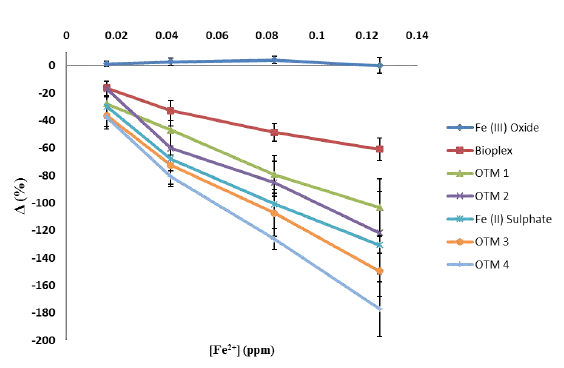
In trace mineral premixes, oxidation-reduction reactions are the predominant cause of vitamin instability. The type of trace mineral will influence its reactivity and more critically, the form that the trace mineral is presented in has an even more significant role to play in influencing vitamin stability. Well documented studies examining vitamin stability in mineral premixes containing inorganic sulphates demonstrate that inorganic minerals are detrimental to the stability of vitamins. Depending on the individual product however, the use of chelated minerals may not cause such a dramatic decrease. A recent study illustrates these effects nicely (Figure 3). The study, which examined Vitamin E function following short term inclusion in mineral premixes containing either inorganic or organic trace minerals demonstrates the importance of carefully choosing premix components. A clear difference can be noted in terms of the pro-oxidant potential of some of the mineral sources, further indicating the contrasting stabilities and thus reactivities of individual products.
Figure 3. Relative activity of Vitamin E following exposure to organic (OTM) and Inorganic (ITM) sources of Fe2+
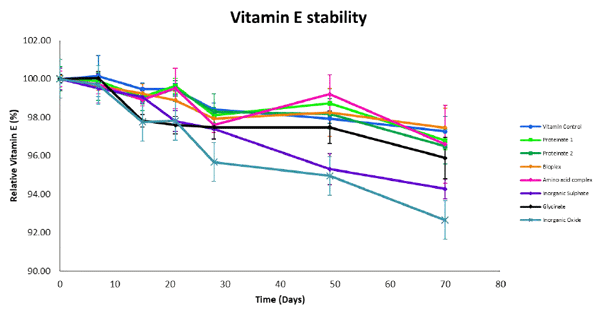
Oxidation-reduction reactions have also been demonstrated to have negative impacts on labile amino acids such as methionine. In recent times, selenium derivatives of methionine (SeMet) have become commonplace in nutritional supplementation strategies as a vehicle to provide the essential trace element selenium. The distribution and accumulation of selenium in animal tissues depends greatly on the type of selenium supplement, with the way the element is presented playing a crucial role in its bioavailability and efficacy. The compounds available for use as Se supplements include the inorganic forms, sodium selenite and sodium selenate, along with organic sources such as selenium-enriched yeast (Se-Y). Additionally, newly developed chemically synthesised sources including L-SeMet and a newer hydroxyanalogue of selenomethionine (2-hydroxy-4-methylselenobutanoic acid, HMSeBA) have been approved for use as feed additives. Selenized yeast, in which selenium is taken up by the yeast during a controlled fermentation process, is the most researched source of selenium and widely regarded as being the most bioavailable organic selenium source for animal and human nutrition. One advantageous attribute of selenium yeast is the acknowledged stability of the selenoamino acids such as SeMet due to the inherent protection afforded them due to their incorporation into yeast protein. The use of chemically synthesised ‘free’ SeMet products such as L-SeMet as a dietary Se source is on the other hand potentially problematic. While methionine is readily oxidised, unprotected SeMet is even more susceptible to oxidation, thus representing an even more labile form of an already labile nutrient.
A recent VTM premix study (manuscript in preparation) comparing the stability of protein bound selenomethionine in selenium yeast with that of chemically synthesized free L-SeMet demonstrated clear differences in not only the stabilities of the selenomethionine sources but also demonstrated the differential impact of trace mineral form on SeMet stability (Figure 4.)
Figure 4. SeMet recovery from VTM premix
In this study the enhanced stability of the selenium yeast selenomethionine is apparent when compared to the extremely labile chemically synthesised selenomethionine source.
Overall it is clear that organic mineral chelates have far less potential for reactivity compared to inorganic mineral sources. However, organic trace mineral products with sub-optimal stabilities can result in inhibition of enzyme activity, induce vitamin instability and result in reduced antioxidant function. These effects can have negative consequences on not only feed quality but also on animal health and performance. Ultimately, diet formulators may well need to pay greater attention to their choice of mineral product to not only minimize the financial costs associated with any potential negative interactions but also to maximise animal wellbeing.
Conclusions
Despite the confusion and often contradictory information that exists, mineral chelation is a relatively straightforward process governed by some fundamental chemistry basics. By carefully considering factors important in mineral chelation, one can begin to distinguish between the products on the basis of their biological stabilities and thus biological bioavailability.
Ultimately, the stability of an OTM is of paramount importance to its bioavailability. During transit through the GI tract and as the pH decreases or acidifies, all OTMs are subjected to physiological forces which can result in the bound mineral complex dissociating and releasing free mineral ions. Organic trace minerals with optimized stability and bond strength will have far less potential for reactivity compared to inorganic sources. However, different forms of organic trace mineral will react differently and cause greater or less inhibition of enzyme activity, vitamin stability and antioxidant function depending on source.
Ultimately, diet formulators may well need to pay greater attention to their choice of individual component to minimize the financial costs associated with negative interactions which could be significant.

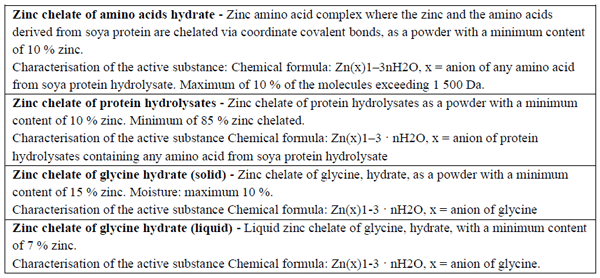
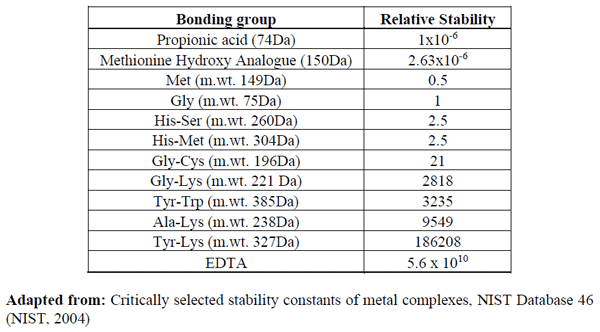

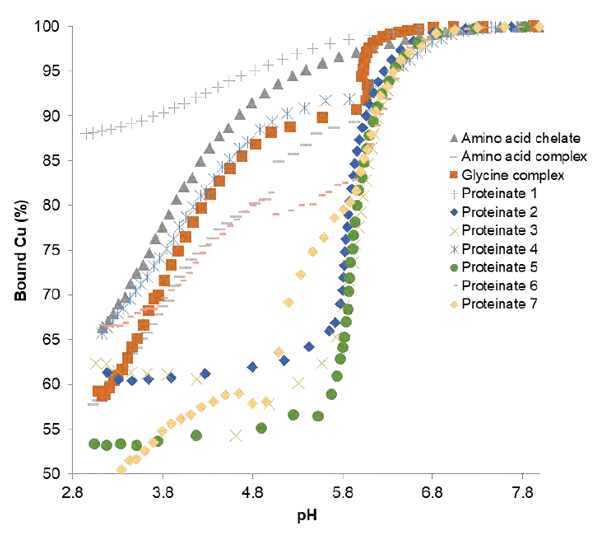



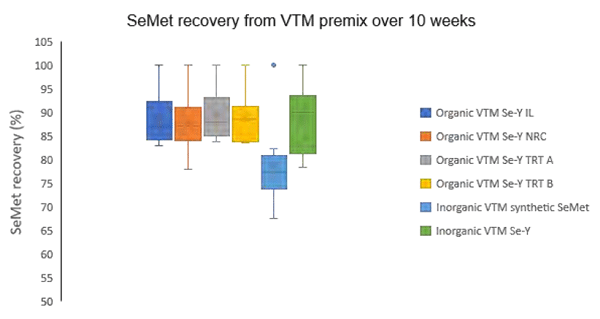








.jpg&w=3840&q=75)